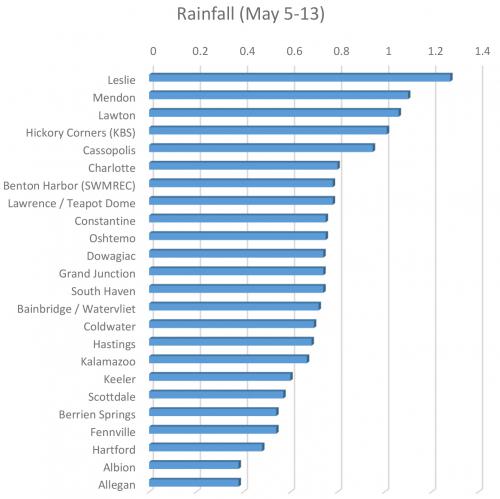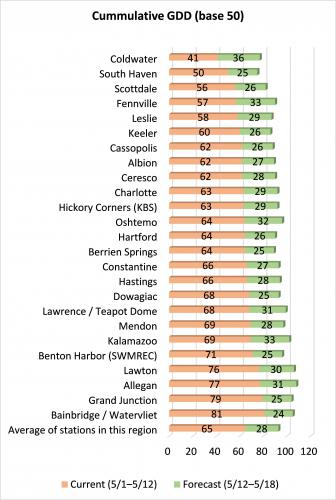Southwest Michigan field crop regional report – May 12, 2016
Rain has been keeping growers out of fields for much of May.
Weather
Rain has kept growers out of the fields for much of May. Producers have been picking out the sandier fields to begin planting. The level of planting progress varies greatly throughout the area on rainfall totals, soil type and equipment size. However, it is no secret that we are substantially behind the pace across the region. Commercial corn presents the largest challenge because the potential yield drag for late planted corn is greater than that for soybeans. Is it better to plant corn into wet conditions and get it in the ground, or wait? To find out the answer, see “Planting corn in wet conditions – is it worth it?”

Rainfall amounts during May 5-13, 2016.
Crop reports
Early planted corn is at V1. Planting progress lags well behind normal. All levels of field preparation are behind, including seed corn planting and spraying.
Based on our black cutworm moth trap catches in our not so widespread black cutworm trapping network, Michigan State University Extension suggests growers consider scouting their unprotected fields (non-Bt commercial fields, Bts that do not contain toxins to protect against black cutworm) that had substantial green material in the fields at the beginning of May. Scouting should begin when we accumulate 300 growing degree-days base 50 since around May 1. Corn planted into fields that were clean during the last week in April shouldn’t need to be scouted. See the table below to see what the GDD accumulations have been in your area.
We suggest you look for ragged leaf edges on plants when you are scouting for clipped plants, which is the sign that armyworm feeding is taking place. This is particularly important if you did not have complete kill of your grassy weeds or cereal/grass cover crops by the end of April.

Cumulative GDD (base 50).
Late April-planted soybeans have emerged. Stands look pretty good on the few fields I have seen. We will be watching the low temperatures over the weekend for chances of soybean seedling damage. Beans should be able to withstand temperatures around 29 degrees without much damage.
Early planted wheat has the flag leaves fully emerged (Feekes 9) or slightly before. Fields continue looking good across the region. With the flag leaf out, now is the time to scout for disease and insect pressures that can move up the plant and threaten the top leaves. I have not seen stripe rust, but others further to the north of us have. I have seen powdery mildew in the lower canopy, but that is not unusual. I would consider regular walks through wheat fields to keep an eye out for armyworm. We have not turned up huge numbers of the pests in traps, but there is enough of them to our south that it warrants watching. Look for ragged leaf margins in fields. The cooler temperatures and moisture really have been almost ideal for wheat growth and development.
There have been fairly low numbers of alfalfa weevil in several fields I have walked this week. Look for the telltale signs of shot-hole feeding in the upper leaves and plant tips. The larvae are really small right now, and well below the treatment threshold of 40 percent of the plants showing signs of feeding. For a more detailed report on alfalfa weevil feeding I have seen this week and potential cutting dates (May 11), see “Alfalfa weevil larval feeding starting in southern Michigan alfalfa fields.”



 Print
Print Email
Email


